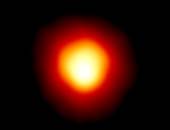|
COMETS EARTH JUPITER KUIPER BELT MARS MERCURY METEORITES NEPTUNE OORT CLOUD PLUTO SATURN SOLAR SYSTEM SPACE SUN URANUS VENUS ORDER PRINTS
PHOTO CATEGORIES SCIENCEVIEWS AMERICAN INDIAN AMPHIBIANS BIRDS BUGS FINE ART FOSSILS THE ISLANDS HISTORICAL PHOTOS MAMMALS OTHER PARKS PLANTS RELIGIOUS REPTILES SCIENCEVIEWS PRINTS
|
Related Document
Download Options
This is the first direct image of a star other than the Sun, made with NASA's Hubble Space Telescope. Called Alpha Orionis, or Betelgeuse, it is a red supergiant star marking the shoulder of the winter constellation Orion the Hunter (diagram at right). The Hubble image reveals a huge ultraviolet atmosphere with a mysterious hot spot on the stellar behemoth's surface. The enormous bright spot, more than ten times the diameter of Earth, is at least 2,000 Kelvin degrees hotter than the surface of the star. The image suggests that a totally new physical phenomenon may be affecting the atmospheres of some stars. Follow-up observations will be needed to help astronomers understand whether the spot is linked to oscillations previously detected in the giant star, or whether it moves systematically across the star's surface under the grip of powerful magnetic fields. The observations were made by Andrea Dupree of the Harvard- Smithsonian Center for Astrophysics in Cambridge, MA, and Ronald Gilliland of the Space Telescope Science Institute in Baltimore, MD. The image was taken in ultraviolet light with the Faint Object Camera on March 3, 1995. Hubble can resolve the star even though the apparent size is 20,000 times smaller than the width of the full Moon -- roughly equivalent to being able to resolve a car's headlights at a distance of 6,000 miles. Betelgeuse is so huge that, if it replaced the Sun at the center of our Solar System, its outer atmosphere would extend past the orbit of Jupiter (scale at lower left). Credit: Andrea Dupree (Harvard-Smithsonian CfA), Ronald Gilliland (STScI), NASA and ESA |
